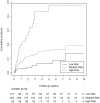Predicting Recurrent Venous Thromboembolism in Patients With Deep-Vein Thrombosis: Development and Internal Validation of a Potential New Prediction Model (Continu-8)
- PMID: 33889600
- PMCID: PMC8055939
- DOI: 10.3389/fcvm.2021.655226
Predicting Recurrent Venous Thromboembolism in Patients With Deep-Vein Thrombosis: Development and Internal Validation of a Potential New Prediction Model (Continu-8)
Abstract
Background: Previous prediction models for recurrent thromboembolism (VTE) are often complicated to apply and have not been implemented widely. Aim: To develop and internally validate a potential new prediction model for recurrent VTE that can be used without stopping anticoagulant treatment for D-dimer measurements in patients with provoked and unprovoked DVT. Methods: Cohort data of 479 patients treated in a clinical care pathway at Maastricht University Medical Center were used. Predictors for the Cox proportional hazards model (unprovoked DVT, male gender, factor VIII levels) were derived from literature and using forward selection procedure. The scoring rule was internally validated using bootstrapping techniques and the predictive ability was compared to existing prediction models. Results: Patients were followed for a median of 3.12 years after stopping anticoagulation treatment (IQR 0.78, 3.90). Sixty-four of 479 patients developed recurrent VTE (13%). The scoring rule consisted of unprovoked DVT (yes: 2 points), male sex (yes: 1 point), and factor VIII > 213 % (yes: 2 points) and was categorized into three groups [i.e., low risk (score 0), medium risk (scores 1, 2, or 3) and high risk (scores 4 and 5)]. The concordance statistic was 0.68 (95% CI: 0.61, 0.75). Conclusion: The discriminative ability of the new Continu-8 score was adequate. Future studies shall verify this score in an independent setting without stopping anticoagulation treatment.
Keywords: clinical decision making; health services research; risk factors; venous thrombosis/epidemiology; venous thrombosis/mortality; venous thrombosis/therapy.
Copyright © 2021 Nagler, Van Kuijk, Ten Cate, Prins and Ten Cate-Hoek.
Conflict of interest statement
MN reports receiving grants from the Swiss National Science Foundation (SNSF), during the conduct of the study; and research grants from Bayer, Stago, Roche diagnostics, outside of the submitted work. The remaining authors declare that the research was conducted in the absence of any commercial or financial relationships that could be construed as a potential conflict of interest.
Figures


Similar articles
-
Prediction of recurrent venous thrombosis in all patients with a first venous thrombotic event: The Leiden Thrombosis Recurrence Risk Prediction model (L-TRRiP).PLoS Med. 2019 Oct 11;16(10):e1002883. doi: 10.1371/journal.pmed.1002883. eCollection 2019 Oct. PLoS Med. 2019. PMID: 31603898 Free PMC article.
-
Prognostic significance of residual venous obstruction in patients with treated unprovoked deep vein thrombosis: a patient-level meta-analysis.Thromb Haemost. 2014 Jan;111(1):172-9. doi: 10.1160/TH13-04-0336. Epub 2013 Oct 24. Thromb Haemost. 2014. PMID: 24154729
-
Patient-level meta-analysis: effect of measurement timing, threshold, and patient age on ability of D-dimer testing to assess recurrence risk after unprovoked venous thromboembolism.Ann Intern Med. 2010 Oct 19;153(8):523-31. doi: 10.7326/0003-4819-153-8-201010190-00009. Ann Intern Med. 2010. PMID: 20956709 Review.
-
A risk score for prediction of recurrence in patients with unprovoked venous thromboembolism (DAMOVES).Eur J Intern Med. 2016 Apr;29:59-64. doi: 10.1016/j.ejim.2015.12.010. Epub 2016 Jan 8. Eur J Intern Med. 2016. PMID: 26775136
-
Long term risk of symptomatic recurrent venous thromboembolism after discontinuation of anticoagulant treatment for first unprovoked venous thromboembolism event: systematic review and meta-analysis.BMJ. 2019 Jul 24;366:l4363. doi: 10.1136/bmj.l4363. BMJ. 2019. PMID: 31340984 Free PMC article.
Cited by
-
Development and validation of a facile rapid assessment scale for perinatal venous thromboembolism in puerperium in Chinese women.BMC Pregnancy Childbirth. 2023 Aug 24;23(1):607. doi: 10.1186/s12884-023-05901-1. BMC Pregnancy Childbirth. 2023. PMID: 37620792 Free PMC article.
-
The Vienna Prediction Model for identifying patients at low risk of recurrent venous thromboembolism: a prospective cohort study.Eur Heart J. 2024 Jan 1;45(1):45-53. doi: 10.1093/eurheartj/ehad618. Eur Heart J. 2024. PMID: 37769352 Free PMC article.
-
Current Knowledge on Factor V Leiden Mutation as a Risk Factor for Recurrent Venous Thromboembolism: A Systematic Review and Meta-Analysis.Front Cardiovasc Med. 2022 Apr 7;9:883986. doi: 10.3389/fcvm.2022.883986. eCollection 2022. Front Cardiovasc Med. 2022. PMID: 35463779 Free PMC article.
-
Prediction of bile duct injury after transarterial chemoembolization for hepatocellular carcinoma: Model establishment and verification.Front Oncol. 2022 Dec 16;12:973045. doi: 10.3389/fonc.2022.973045. eCollection 2022. Front Oncol. 2022. PMID: 36591492 Free PMC article.
-
Role of factor VIII, IX, and XI in venous thrombosis recurrence risk in adults and children: A systematic review.Res Pract Thromb Haemost. 2023 Feb 2;7(2):100064. doi: 10.1016/j.rpth.2023.100064. eCollection 2023 Feb. Res Pract Thromb Haemost. 2023. PMID: 36852262 Free PMC article.
References
LinkOut - more resources
Full Text Sources
Other Literature Sources

